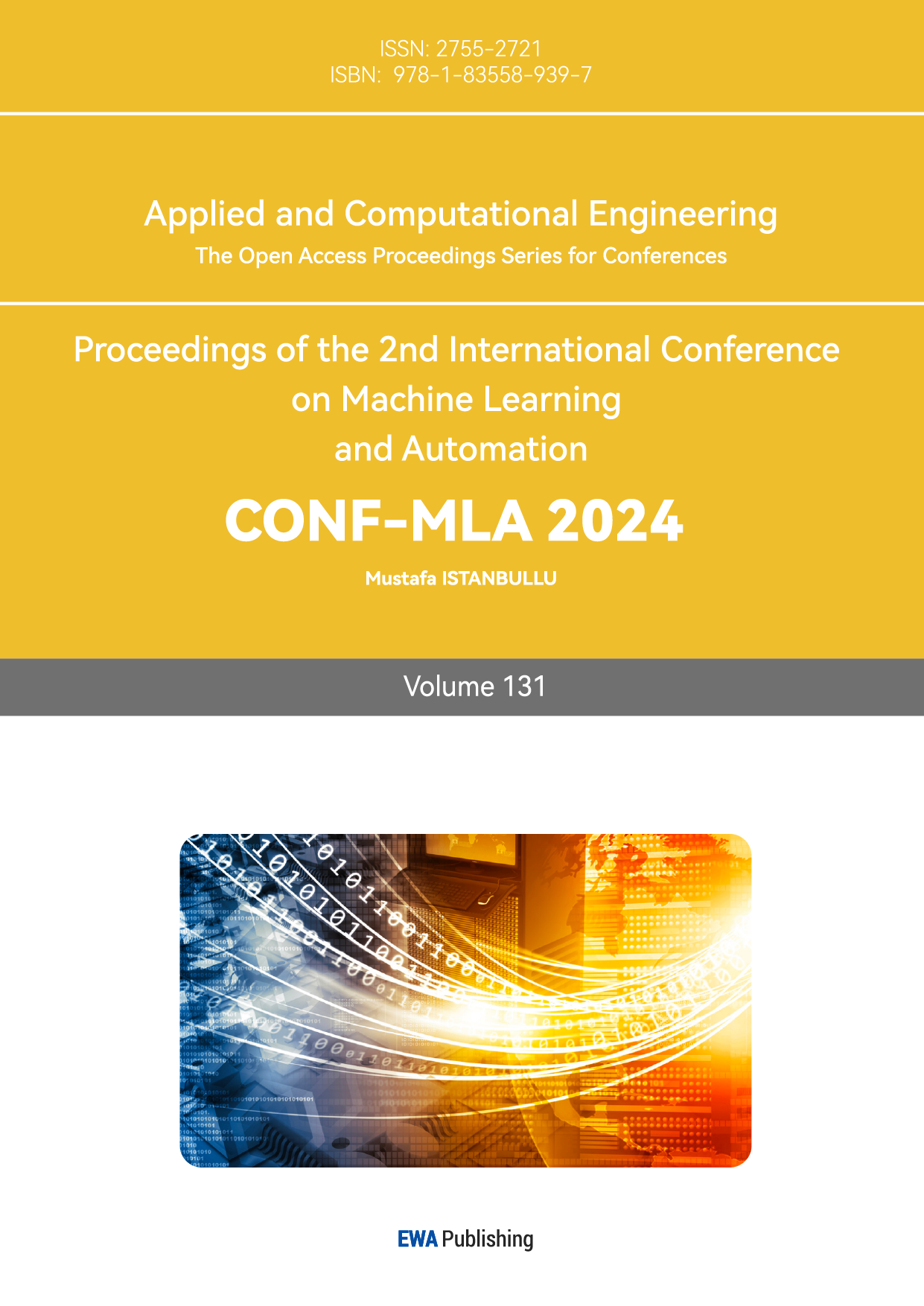1. Introduction
1.1. Background Intro
With the end of COVID-19, there is a growing enthusiasm to explore the world after a long period of isolation. Global tourism is making a strong comeback. As reported by the World Tourism Organization (UNWTO 2023), the first quarter of 2023 saw double the number of international travelers compared to the same period in 2022, totaling an estimated 235 million tourists.[1] As the demand for travel increases, so does the need for personalized travel plans among travelers. They expect customized travel experiences to meet their interests and preferences. However, the large amount of travel information available on the Internet often overwhelms users, leading to poor planning and decision overload. This phenomenon has driven the development of AI technology, especially the broad application of large-scale language modeling and recommender systems. By analyzing user preferences in real-time, AI-powered systems can provide travelers with personalized trips and recommendations, simplify the planning process, and significantly improve the customization and satisfaction of the user experience.
1.2. Application Intro
The project integrates artificial intelligence into a personalized trip-planning platform to overcome the limitations of traditional travel planning. The software analyzes user data, including travel preferences, spending limits, activities and previous experiences, and uses artificial intelligence (AI) to create personalized itineraries to match each user's individual needs. Similarly, Li et al. point out that massive tourist-related big data are generated from three primary sources: user-generated content data from social media, spatial–temporal data from IoT and transaction data from the internet.[2] The software makes planning simpler by automating the design of itineraries and guarantees a smooth, pleasurable user experience. By utilizing this feature, customers may investigate locations, places to stay, and events according to their preferences without having to manually search many platforms.
1.3. Contribution Intro
Our contribution included the development of a comprehensive travel planning platform. The platform contains low-fidelity designs, high-fidelity models, interactive prototypes created in Figma, and demos developed using HTML and CSS. These components show how the system may include artificial intelligence to speed up the vacation planning process by providing personalized routes based on user preferences. This article focuses on improving the AI platform's potential to improve user experience and trip planning efficiency. It includes the research, design, and user assessment of the platform. Our goal is to provide a trip planning experience that is more customized, intuitive, and responsive to individual needs in real-time by combining AI-driven recommendations with user-friendly design. This creative method not only makes passenger decision-making easier but also creates new opportunities for AI integration in the tourism sector.
2. Iteration 1
2.1. Need Finding
As the pandemic era comes to an end, the tourism industry is experiencing a steady recovery, leading to a growing demand for travel planning. Chinese travel enthusiasts typically check train and flight tickets manually and use social media platforms like Xiaohongshu to explore others’ travel guides before crafting their own plans. This traditional approach is not only time-consuming but often results in suboptimal itineraries. Meanwhile, recent advancements in large-scale models, such as GPT, have opened up new possibilities. Many people have started using GPT for travel planning; however, GPT often provides vague, conceptual responses that fail to meet the users' need for detailed and precise travel itineraries[3]. In response to these user needs, we came up with the idea of creating a travel planner webpage powered by GPT.
2.2. Pain Points Finding
When using GPT for travel planning, users typically need to go through at least four steps. The first step is to assign GPT a role, asking it to act as a local or a tour guide to provide suggestions and plans. Next, users must provide background information and requirements, such as the destination, travel dates, budget, and more. The third step is to specify what GPT should do, like generating a specific type of travel itinerary, for instance, recommending homestays for accommodation. The final step involves offering additional input, such as mentioning that there are elderly and children in the group, so the itinerary should not be too exhausting. These questions are essential to create a feasible plan, making the process of using GPT for travel planning quite cumbersome, time-consuming, and complex. Despite this, the generated plans often have several issues, requiring users to ask follow-up questions multiple times before arriving at a satisfactory result[4].
To address this pain point, we decided to break down the user’s needs into ten smaller questions, which users can clarify on our webpage before interacting with GPT. This approach minimizes the need for repeated queries, saving time. Moreover, if users find a travel plan on social media platforms like Xiaohongshu and want to use it as a reference, they currently have to resort to taking screenshots or manually copying the details. Our envisioned webpage would allow users to directly adapt others' plans and customize the details to suit their own preferences.
2.3. Status Quo Finding
Currently, using GPT to generate travel plans involves a multi-step and often complex process. Users must first provide detailed background information, including their destination, travel dates, budget, and specific preferences, such as preferred types of accommodations or travel styles. After this, they often need to repeatedly prompt GPT for further details, adjustments, or clarifications, as the initial responses are usually too vague or miss crucial aspects of the user's requirements. Additionally, users often face difficulties in refining the suggested plans to fit their unique needs, such as accommodating elderly travelers or specific activities. This process not only requires significant time and effort but also results in varying levels of satisfaction, as users frequently have to ask multiple follow-up questions to arrive at a suitable travel itinerary. Overall, the current use of GPT for travel planning is marked by a lack of efficiency and a high level of manual input.
2.4. Design Survey & Find Participants
Although we have conducted a comprehensive user needs analysis and a clear pain points assessment, we still encountered significant challenges while designing the homepage of the website. Therefore, we consulted an expert in this field, who suggested adopting a co-creation approach. This involved conducting focus group interviews with the website's core potential users and using their feedback to shape the homepage content.
To achieve our objective, we focused on several key aspects during the interviews: the overall aesthetic and comfort of the website's design, the reasonableness of the nine questions posed to users, and the content users most wish to see on the homepage. Our interviewees were frequent travelers among our friends, and they provided numerous constructive suggestions. For instance, they recommended featuring travel plans shared by other users on the homepage, as they sometimes prefer to refer to others' plans and make modifications based on them.
3. Iteration 2
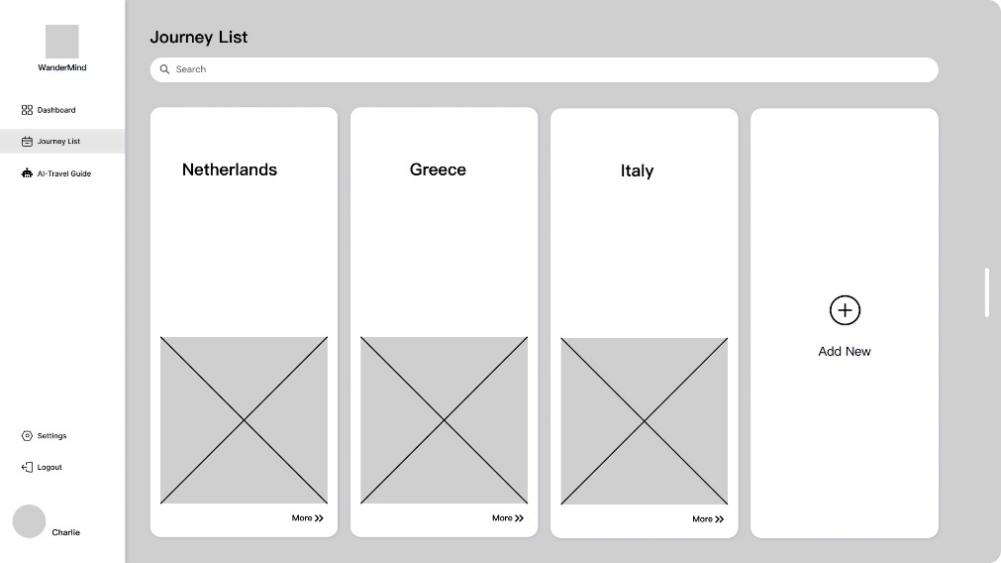
Figure 1. Journey List Page_Lo-fi
Journey List Page: Displays saved and recent journeys, with options to add new journeys.
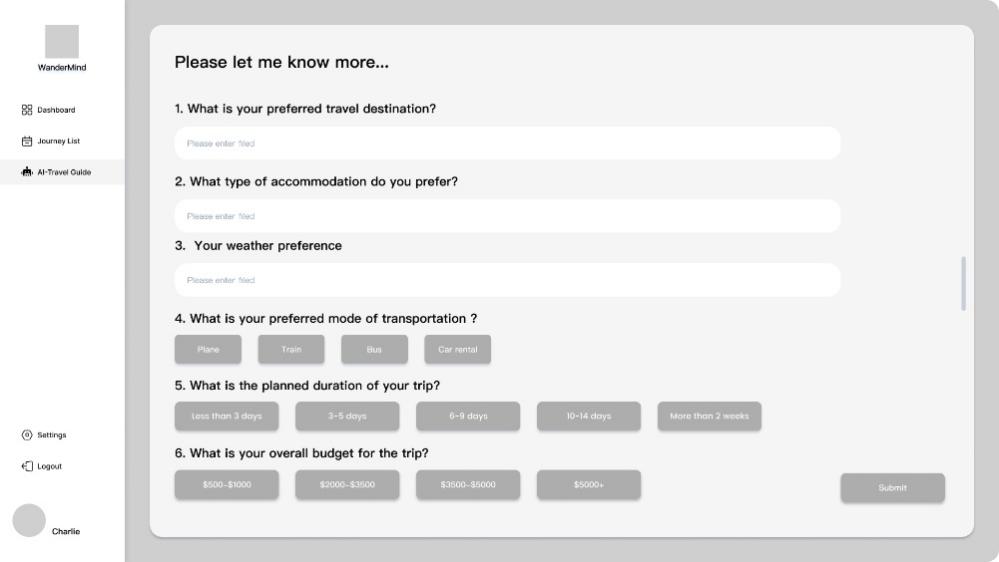
Figure 2. Question Page_Lo-fi
Question Page: This page is designed to collect user preferences through a series of interactive questions, enabling the system to generate personalized itineraries. The questions gather details such as preferred destinations, travel budget, accommodation type, and activity preferences.
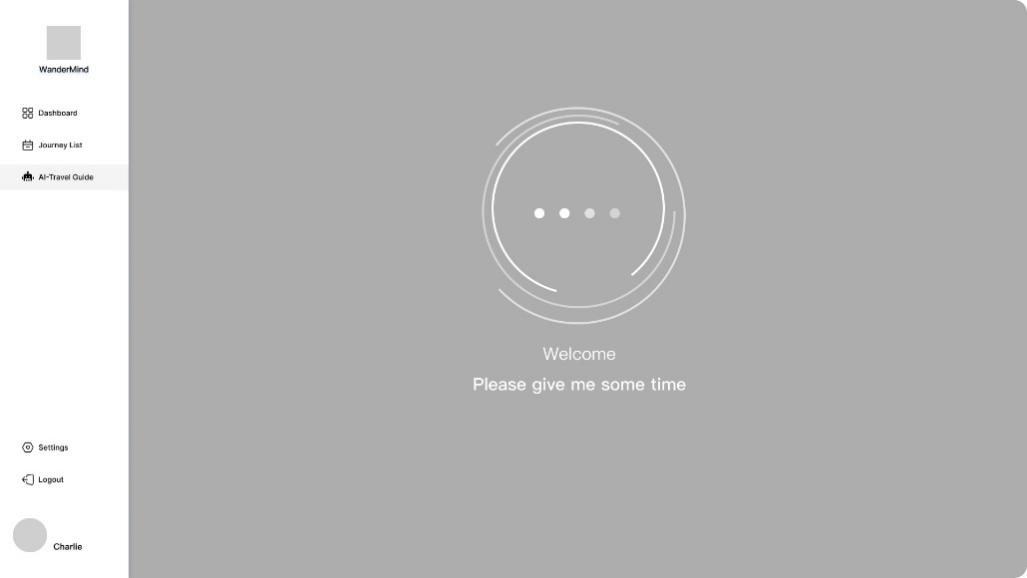
Figure 3. AI Voice Interaction Page_Lo-fi
AI Voice Interaction: An AI-powered travel guide that assists users in exploring or modifying their travel plans through natural language processing.
The initial phase of Iteration 2 focused on developing a low-fidelity prototype that integrated all of the core functionality of the travel planning platform. This low-fidelity design provided the basic visual and functional framework that allowed us to test key features such as destination filtering, personalized itinerary generation, and user preference saving. The main goal was to ensure that the user experience flow was intuitive (even at this preliminary stage) while covering all the expected features of the final product.
Participatory Design:
To refine the low-fidelity prototype, we used a participatory design methodology that involved potential users in the evaluation process. Users were asked to interact with the low-fidelity product and provide feedback on various features. Through this process, we learned which features were intuitively useful and which elements needed improvement. Users highlighted the convenience of using filters to customize travel preferences, but they also pointed out some areas that needed attention, particularly the itinerary customization feature. In addition, users felt that our current target audience was unclear. Specifically, they pointed out that the prototype only offers an “unsure destination” option, while many users prefer to enter a specific destination. The number of users who already know their destination is likely to far outnumber the number of users who have not yet identified their destination.
This feedback influenced our later design direction for the high-fidelity prototype and prompted us to enrich the user experience by adding an option for the user to select a specific destination or an indeterminate destination. The user testing and interviews not only guided the development of the high-fidelity product, but also helped us ensure that user needs stayed at the top of the list of priorities throughout the design evolution. This feedback allowed us to improve the user interface and address any pain points that surfaced during the early testing phase.
4. Iteration 3
4.1. Design high-fi product
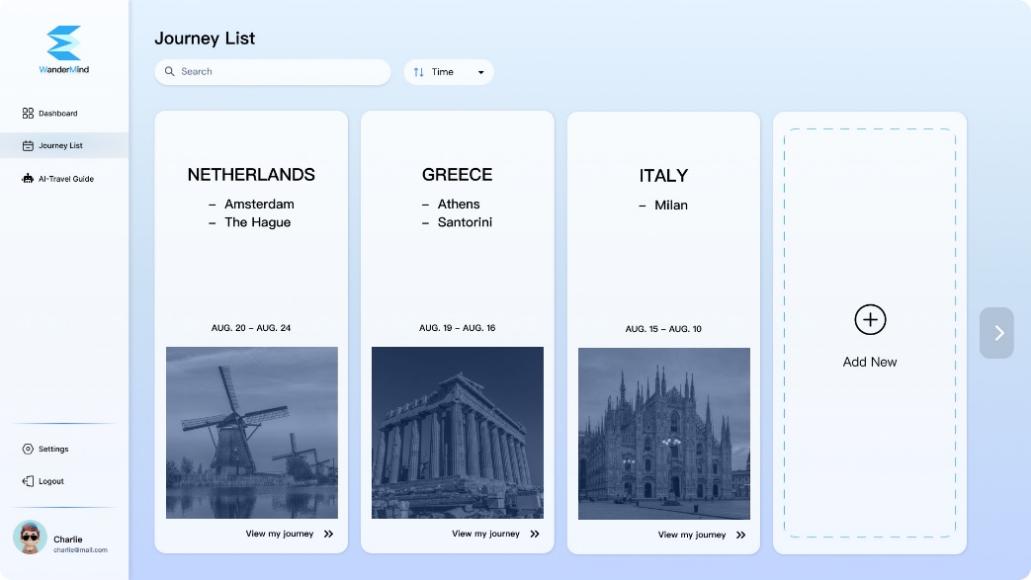
Figure 4. Journey List Page_Hi-fi
Journey List: Users can view and manage saved and upcoming travel plans.
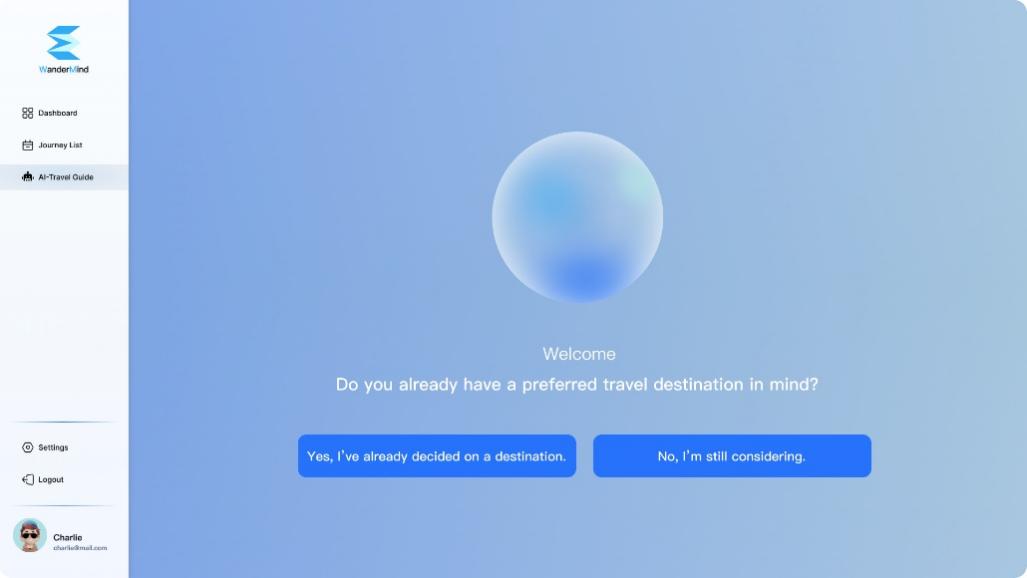
Figure 5. AI-Travel Guide Page_Hi-fi
AI-Travel Guide: An AI-assistant that provides personalized recommendations based on user input and preferences.
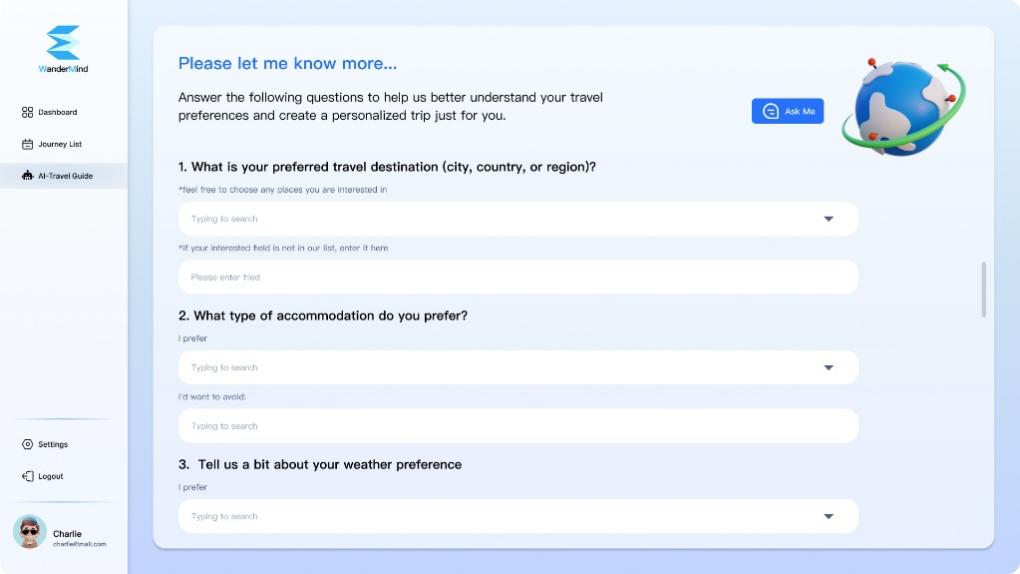
Figure 6. Preference Questionnaire Page_Hi-fi
Preference Questionnaire: The system provides users with a series of detailed questions about their travel preferences to obtain more detailed data for customized journeys.
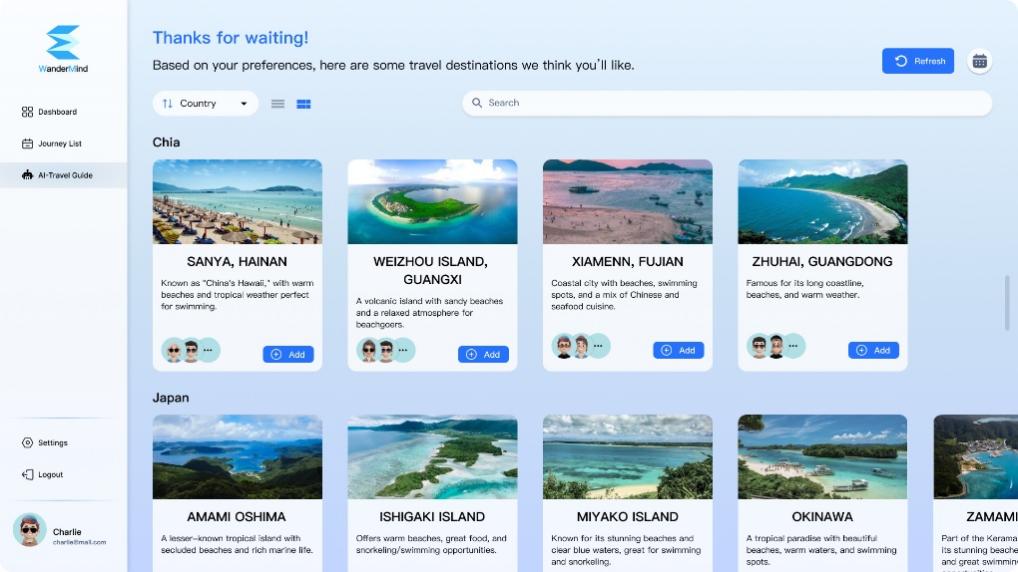
Figure 7. Destination Results Page_Hi-fi
Destination Results Page: Display travel recommendations tailored to the user's preferences, giving users a clear interface with a variety of choices.
Model Evaluation / Product Evaluation
Evaluate the effectiveness of hi-fi products by conducting functional and user experience tests. Functionality was tested by ensuring that all interaction elements (buttons, filters, AI responses) worked seamlessly on a variety of devices. Additionally, we collected user feedback to assess interface clarity, responsiveness, and overall satisfaction. The evaluation also focused on how well the product generated personalized travel itineraries and whether it met user expectations for real-time interactions.
4.2. Participatory design
We conducted a participatory design session with a diverse group of users to gather insights into the high-fidelity prototype. We designed a survey to gather both quantitative and feedback on several key areas: usability of the interface, effectiveness of the AI travel guide, difficulty in answering preference questions, and overall satisfaction with the personalized destination results. During the session, users interacted with the prototype and completed the survey, which gave us a deeper understanding of the product's strengths and areas for improvement. After analyzing the survey data, we identified patterns with a particular focus on the usability of the AI and the importance of travel advice accuracy. The feedback highlighted opportunities to further improve the system, particularly in terms of enhancing the functionality of the AI and improving the customization of travel plans.
According to Norman, when the affordances of a design are clear and the mapping is natural, users can easily figure out how to interact with the system, making it intuitive to use.[5] However, the level of detail in the AI responses could be improved, especially in providing more accurate travel advice. Compared with the low-fidelity version, the design of the high-fidelity products is more refined and the integration of personalized functions is higher, so the user satisfaction is significantly improved. The survey features also received positive feedback, although some users suggested adding more customization options to enhance travel planning.
The high-fidelity prototype demonstrates the potential of artificial intelligence for personalized travel planning. Through user testing, interviews, and iterative development, we have created an interactive platform that provides users with a tailored travel experience. While the product demonstrates powerful usability and personalization capabilities, further improvements are needed to improve AI accuracy and expand user customization options. In summary, incorporating AI into travel planning offers a promising avenue for the travel industry to create efficient, user-friendly tools.
Acknowledgment
Boke Chen and Jingwan Liu contributed equally to this work and should be considered co-first authors.
References
[1]. García-Madurga, Miguel-Ángel, and Ana-Julia Grilló-Méndez. 2023. "Artificial Intelligence in the Tourism Industry: An Overview of Reviews" Administrative Sciences 13, no. 8: 172. https://doi.org/10.3390/admsci13080172.
[2]. A Leung, Xi Yu. "Technology-Enabled Service Evolution in Tourism: A Perspective Article." Tourism Review of AIEST - International Association of Scientific Experts in Tourism 75, no. 1 (2020): 279-282. doi:https://doi.org/10.1108/TR-06-2019-0229. https://login.libproxy.newschool.edu/login?url=https://www.proquest.com/scholarly-journals/technology-enabled-service-evolution-tourism/docview/2532604325/se-2..
[3]. Xie, Jian, Kai Zhang, Jiangjie Chen, Tinghui Zhu, Renze Lou, Yuandong Tian, Yanghua Xiao, and Yu Su. "TravelPlanner: A Benchmark for Real-World Planning with Language Agents." ArXiv abs/2402.01622 (2024).
[4]. Rosa, Tomás de la, Sriram Gopalakrishnan, Alberto Pozanco, Zhen Zeng, and Daniel Borrajo. "TRIP-PAL: Travel Planning with Guarantees by Combining Large Language Models and Automated Planners." ArXiv abs/2406.10196 (2024).
[5]. Norman, Donald A. The design of everyday things. New York: Basic Books, A Member of the Perseus Books Group, 2013.
Cite this article
Chen,B.;Liu,J. (2025). User Experience Improvement Through Personalized Travel Planning: A Study of AI Travel Customization. Applied and Computational Engineering,131,141-147.
Data availability
The datasets used and/or analyzed during the current study will be available from the authors upon reasonable request.
Disclaimer/Publisher's Note
The statements, opinions and data contained in all publications are solely those of the individual author(s) and contributor(s) and not of EWA Publishing and/or the editor(s). EWA Publishing and/or the editor(s) disclaim responsibility for any injury to people or property resulting from any ideas, methods, instructions or products referred to in the content.
About volume
Volume title: Proceedings of the 2nd International Conference on Machine Learning and Automation
© 2024 by the author(s). Licensee EWA Publishing, Oxford, UK. This article is an open access article distributed under the terms and
conditions of the Creative Commons Attribution (CC BY) license. Authors who
publish this series agree to the following terms:
1. Authors retain copyright and grant the series right of first publication with the work simultaneously licensed under a Creative Commons
Attribution License that allows others to share the work with an acknowledgment of the work's authorship and initial publication in this
series.
2. Authors are able to enter into separate, additional contractual arrangements for the non-exclusive distribution of the series's published
version of the work (e.g., post it to an institutional repository or publish it in a book), with an acknowledgment of its initial
publication in this series.
3. Authors are permitted and encouraged to post their work online (e.g., in institutional repositories or on their website) prior to and
during the submission process, as it can lead to productive exchanges, as well as earlier and greater citation of published work (See
Open access policy for details).
References
[1]. García-Madurga, Miguel-Ángel, and Ana-Julia Grilló-Méndez. 2023. "Artificial Intelligence in the Tourism Industry: An Overview of Reviews" Administrative Sciences 13, no. 8: 172. https://doi.org/10.3390/admsci13080172.
[2]. A Leung, Xi Yu. "Technology-Enabled Service Evolution in Tourism: A Perspective Article." Tourism Review of AIEST - International Association of Scientific Experts in Tourism 75, no. 1 (2020): 279-282. doi:https://doi.org/10.1108/TR-06-2019-0229. https://login.libproxy.newschool.edu/login?url=https://www.proquest.com/scholarly-journals/technology-enabled-service-evolution-tourism/docview/2532604325/se-2..
[3]. Xie, Jian, Kai Zhang, Jiangjie Chen, Tinghui Zhu, Renze Lou, Yuandong Tian, Yanghua Xiao, and Yu Su. "TravelPlanner: A Benchmark for Real-World Planning with Language Agents." ArXiv abs/2402.01622 (2024).
[4]. Rosa, Tomás de la, Sriram Gopalakrishnan, Alberto Pozanco, Zhen Zeng, and Daniel Borrajo. "TRIP-PAL: Travel Planning with Guarantees by Combining Large Language Models and Automated Planners." ArXiv abs/2406.10196 (2024).
[5]. Norman, Donald A. The design of everyday things. New York: Basic Books, A Member of the Perseus Books Group, 2013.





